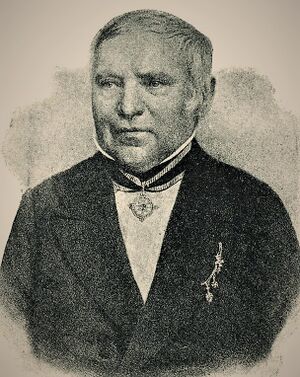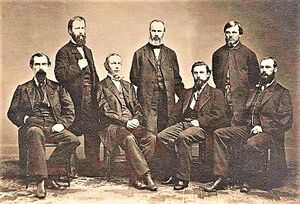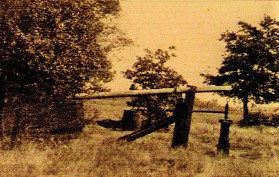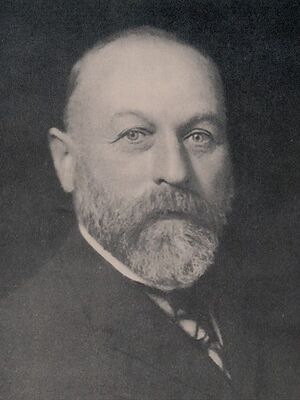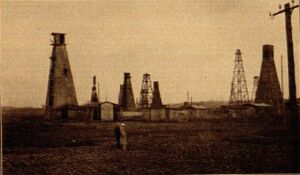Chronology of the early German petroleum history
The original version of this article was created by Francesco Gerali, 2020 Elizabeth & Emerson Pugh Scholar in Residence at the IEEE History Center
It is recommended this article be cited as:
F. Gerali (2020). Chronology of the early German petroleum history, Engineering and Technology History Wiki. [Online] Available: https://ethw.org/Chronology_of_the_early_German_petroleum_history
1480-1490. Pamphlets describe medicinal value of petroleum and bitumen produced from the seepages and rock crevices at Wietze (Hanover, Germany), Tegernsee (Southern Bavaria).
1749-1756. Pharmacist Caspar Neumann (1683-1737) wrote for the first time on the concept of fossil fuels in the seven posthumously books the Chymiae medicae dogmatico-experimentalis.
1827. Berlin is the first city in Germany to be illuminated with natural gas.
1839. Prof. Christian Gottfried Ehrenberg[1] published the theory on petroleum originated in marine infusorial rocks[2] composed of siliceous remains of diatoms (FIG. 1). Later in 1867, his thesis was reproposed by the American geologist Josiah Dwight Whitney,[3] director of the Second Geological Survey of California (FIG. 2).
1851. Two factories for producing paraffin from oil shale are established near Bonn.
1858. Prof. Dr. Christian. K. Hunaus, geologist, stuck a petroleum well at a depth of about 330 feet while drilling in Wietzel, the German province of Hanover. Hunaus' discovery was accidental, as he was looking for coal deposits at the request of Hannovarian authorities. (FIG. 3).
1860-1862. The first refinery to obtain mineral oil and paraffin from shale rocks is established in 1860 in the city of Salzbergen (Lower Saxony) and named 'Paraffin and Photogen Factory. The output was poor, and therefore in 1861-1962 management transformed the plant into a full petroleum refinery. This was the first industrial-scale refinery opened in Germany and still operating as of 2021 in the same area where it was founded (FIG. 4)
1861. December, W. W. Murphy, the United States Consul at Frankfurt, presented Pennsylvanian petroleum to the German authorities.
1866. The Kaiser Patent Office issued the patent for “(…) a deep drilling method through application of electrical power transmission with the elimination of the drilling stem (…)” to the German inventor Carl Schwend for his “Electro-Drill” device.
1876. An internal combustion engine using gasoline vapor is assembled by Dr. N. A. Otto of Cologne, Germany. His motors were too heavy for use in road vehicles and they found application as stationary engines installed mostly in factories.
1879. The first important leap to gasoline for automotive use was made by German engineer Karl Friedrich Michael Vaillant Benz (1844-1929), a graduate of the Karlsruhe Institute of Technology,[4] who built the first gasoline fueled mono cylindric motor prototype.
1882. Herman Frasch[5] (1851-1914), chemist, developed a process, bearing his name, for the removal of sulfur from crude oils (FIG. 5). The son of a pharmacist, Herman Frasch was born 25 December 1851 in Gaildorf, Wurttemberg, Germany. In 1868, he immigrated to the United States and taught at the Philadelphia College of Pharmacy[6] while studying chemistry. He developed an improved process for refining wax in 1876 and sold it to a subsidiary of Standard Oil in 1877. He moved to Cleveland where started his own business as a chemical consultant to the petroleum industry. Frasch developed a process for reducing the sulfur content of “sour” petroleum. This was an extremely important achievement, as a high sulfur content makes petroleum difficult to refine, degrades ultimate products and his potentially harmful for the utilizer. At the time, the most important application was the production of pure kerosene free of foul odors and smoke. He sold the process to Canada’s Imperial Oil Company in 1882.
1909-1925. Karl Oswald Viktor Engler and Hans von Heimhalt Höfer in six volumes published the landmark technical encyclopedia on petroleum Das Erdöl, seine Physik, Chemie, Geologie, Technologie und sein Wirtschaftsbetrieb. Leipzig: S. Hirzel:
- Band Die Chimie und Physik des Erdöls.
- Band Die Geologie, Gewinnung und der Transport des Erdöls.
- Band Die Technologie des Erdöls und seiner Produkte.
- Band Die Prüfung und Verwendung des Erdöls, des Erdgases und der Erdölprodukte.
- Band Die Erdölwirtschaft (I)).
- Band Die Erdölwirtschaft (II).
1921. The Seismos GmbH - Zur Erforschung von Gebirgsschichten und Nutzbaren Lagerstätten nach dem Seismischen Verfahren (Seismos GmbH - For the Exploration of Mountain Strata and Usable Deposits Using the Seismic Method) was founded on April 4, 1921, by Ludger Benedikt Mintrop in Dortmund (later based in Hannover). Mintrop established the company with the ambitious goal of searching for crude petroleum and gas reservoirs on a global scale. His work received support from his teacher Emil Wiechert and was even financed by five German metallurgical and mining companies.
1929. Germany had three petroleum district in its boundaries: (1) the North German, (2) the Rhenish and (3) the Subalpine province. About 200 independent small petroleum companies guarantee a 7500-daily barrel production (FIG. 6 & 7).
1930. Ira Rinehart in 1930 published his Report on the Oil Fields of Northwest Germany (Lord Baltimore Press, Baltimore, MD, USA), the most detailed work on the German petroleum sector written in English (FIG. 8).
1932. Alfred Bentz organized the conference of the Deutsche Geologische Gesellschaft[7] (the German Geological Society) on petroleum geology (FIG. 9 & 10). Attended by representatives of the petroleum industry, politicians, engineers and geologists, the program offered a broad review of the state of the art concerning drilling techniques, geophysical methods, stratigraphy, and prospecting.
1934. On April, the Reich decided on the granting of subsidies to exploration drilling. The DGG was tasked to supervise the geological part of this drilling program; it was constituted the Institute for Oil Geology in the organigram of the Geological Survey. Benz was appointed head of this office and three geologists were attached to him. Eventually, in 1936 the first successes of the Reich drilling subsidy turned up. The drilling program was further intensified, and plans were made for the war effort.
See also
- Chronology of the early Russian petroleum history
- Chronology of the early Latin American petroleum history
- Chronology of the early Canadian petroleum history
- Chronology of the early French petroleum history
- Hans Höfer von Heimhalt
- International Petroleum Congress
- List of Petroleum History Museums
- Ludger Benedikt Mintrop
- Petroleum Historical Bibliography
- Petroleum Historical Terminology
References
Craig, J., Gerali, F., Macaulay, F. & Sorkhabi, R. (eds) 2018. “Introduction”. History of the European Oil and Gas Industry. Geological Society, London, Special Publications, 465, 1-24.
Forbes, R.J. 1958. Studies in Early Petroleum History. E.J. Brill, Leiden, The Netherlands.
Forbes, R.J. 1959. More Studies in Early Petroleum History. E.J. Brill, Leiden, The Netherlands.
Gregorius, Rudolf. 1908. Mineral Wazes, Their Preparation and Uses. (Tr. from the German by Salter, Chas.) Scott, Greenwood & Son, London.
Gunther, A.E. 1948. “The German war for crude oil in Europe 1934–1945: Chapter XIII – Petroleum literature in Grossdeutschland, 1933–1945”. The Petroleum Times, 30, 371-373.
Heck, P. 1907. Die deutsche Erdölindustrie. Aachen, Germany: Aachener Verlags und Druckerei-Gesellschaft m.b.H.
Kölbl-Ebert, Martina. 2018. “German petroleum geologists and World War II”. In Craig, J., Gerali, F., Macaulay, F. & Sorkhabi, R. (eds), History of the European Oil and Gas Industry. Geological Society, London, Special Publications, 465, 391–407.
Owen, Edgar Wesley., Dott, Robert H., DeGolyer, E., Southwestern Federation of Geological Societies, and American Association of Petroleum Geologists. 1975. Trek of the Oil Finders: A History of Exploration for Petroleum. Memoir (American Association of Petroleum Geologists); 6. Tulsa, Okla.: American Association of Petroleum Geologists.
Rinehart, Ira. 1930. Report on the Oil Fields of Northwest Germany. Lord Baltimore Press, Baltimore, MD, USA.
Strippelmann, Leo. 1878. Publishes the Die Petroleum-Industrie Oesterreich-Deutschlands: dargestellt zur Klarstellung deren Wichtigkeit und Zukunft, und zur Aufklärung des, für diese Industrie sich interessirenden Capital’s in geschichtlicher, geologisch-bergmännischer, wirthschaftlicher und technischer Beziehung. Leipzig: G. Knapp, Verlagsbuchhandlung.
Testa, Stephen. 2002. “Josiah D. Whitney and William P. Blake: Conflicts in Relation to California Geology and the Fate of the First California Geological Survey”. Earth Sciences History, 21(1): 46-76.
Vassiliou, M. S. 2009. The A to Z of the petroleum industry. Lanham, Md: Scarecrow Press.
Vassiliou, M. S. 2009. Historical dictionary of the petroleum industry. Lanham, Md: Scarecrow Press.
Vassiliou, M. S. 2018. Historical dictionary of the petroleum industry. Lanham, Maryland : Rowman & Littlefield.
Further Reading
- ↑ https://www.britannica.com/biography/Christian-Gottfried-Ehrenberg
- ↑ https://www.spectrumchemical.com/OA_HTML/chemical-synonym_Infusorial-Earth.jsp?pSynonym=Infusorial-Earth
- ↑ https://archives.yale.edu/agents/people/89707
- ↑ https://www.kit.edu/kit/english/1083.php
- ↑ https://digitalcommons.lsu.edu/gradschool_disstheses/3971/
- ↑ https://www.usciences.edu/about/history/index.html
- ↑ https://www.dggv.de/en/about-dggv/history.html
